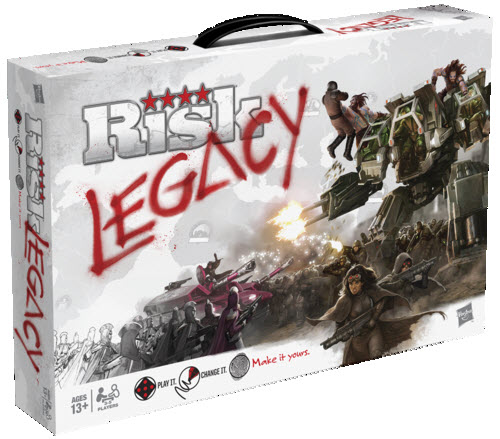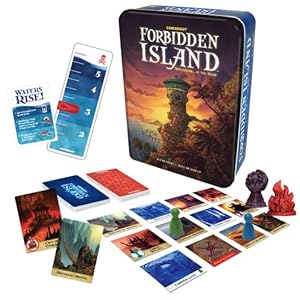We have hit
that time of the year when everyone is wondering what to gift to give. I thought I would give you my two cents on
what game to give as holiday gifts. I
have done this in the past in spoken word, and have already helped a few people
this year, but now that I am blogging I figured I would write it down – before
you spend all your gift money on Black Friday.
First, let’s
talk about where these games can be purchased.
There are a lot of websites, blogs and podcasts that will give you game
gift ideas. My approach will be a bit
unusual; I expect that you, the reader, are not a “gamer”. I am writing this as I do the rest of the
articles here, with a focus for those who are casually interested in the
boardgaming hobby. Therefore, while
these games will be available through
local game stores or online, they should
also be available through some larger, mass-market outlet. These games are not only easier to learn and
play but also easier to find. Hey,
that’s why I’m here!
Links to my
reviews of these games are embedded in the text. Now back to the show!
Type 1: “I loved playing games as a kid!”
This person
has fond memories of playing
Risk and
Monopoly as a kid, and probably
played these games at least some as a teenager.
He or she might well play them now, if they could find the time and
opponents who don’t mind a four hour game.
This gift recipient will love the revised edition of
Risk (or the deluxe version,
Risk: Onyx Edition)
. The game plays in roughly
90 minutes according to the box, and experience shows that to be accurate. This game has all of the familiar game play
and fun of the original, with different end game conditions to close out the
game earlier.
A copy of the revised version of Risk
can be found at nearly any mass media outlet.
Type 2: “I loved playing Clue!”
It would be
natural to assume that this would be a subcategory of those above, but it’s
likely this person did not like
Monopoly or
Risk.
There are many people, like my sister, who do not like direct
confrontation in a game, and prefer the skullduggery of
Clue. Honestly, one of the
best games for this person is to get them a new copy of
Clue. Of all of the
mass-market games of old, this is actually one of the decent ones in the
mystery genre. However, I would first
look for a copy of
Scotland Yard. I have not played this game, but it was
published in the early ‘80’s and is still in print. Furthermore, it won the
Spiel des Jahres in
1983. I am completely comfortable
recommending this game.
Scotland
Yard is currently being sold at Barnes and Noble.
Type 3: “We love/loved Scrabble.”
Interestingly,
this is one game adults continue to play, and Scrabble has never had the reputation as something “only kids
play”. This group is at once the easiest
and the hardest to buy for, since they are open to playing games but laser
focused on one. A more focused approach
is called for:
Subtype 1: Families with small children. Buy
Qwirkle. Not only is this the
latest Spiel des Jahres winner, but it has been around in the United States for several years.
Qwirkle can be found many places,
including stores for educators. Target
has been carrying it almost since first publication.
Subtype 2: Families older children or no
children. Find a copy of
Bananagrams. This is definitely a game for wordies, but it
plays in 20 minutes. Furthermore, it
plays five and could probably play as many as six if you wanted to push it (not
that I am recommending it!). I
originally blew it off, but after playing it found that I really enjoy it. This is one of the more economical choices,
too. Furthermore, it’s actually hard to
find a store that
doesn’t carry
Bananagrams; it’s the easiest game to
find.
All of the mass-market outlets will have Bananagrams.
Type 4: “My family plays/played cards when
at family functions.”
This is
another tough group. There are some
great card games out there, and I will recommend something that is going to
make hardcore gamers roll their eyes: Mille Bornes. This is not a highly regarded game in the
boardgaming community, but my wife and I have had a lot of fun with it and have
introduced it to friends successfully.
The only warning I have is that there is a lot of “take that” in the
game, so with little ones it can result in wailing and gnashing of teeth. This game comes in a deluxe edition that is
reasonably priced, and the basic version
is found everywhere in the card game section of the store. The basic version is very inexpensive, so it
works as a stocking stuffer or in a $10 gift exchange as well.
Type 5:
The family/casual boardgamer
This starts
to get tricky, because there is the chance that you will give a gift they
already have. However, if they have a
few hobby games that they play casually, there is a decent chance they don’t
have Dominion. I realize in writing this post that I have
been remiss; I have not reviewed this game.
I will correct that very soon. In
the meantime, trust me here. This is an
excellent game. It’s a small step up in
complexity from Ticket to Ride or any
of the other games mentioned here, but anyone with a little experience will be
able to read the rules and play. This
game works pretty well for those who used to play Magic: The Gathering, Pokémon
or other collectible card games. Dominion
has recently become available at Target and Barnes and Noble.
Type 6: The Dedicated Chess Player
Handkerchiefs. Seriously, this person is not hard to buy a
game for; they are impossible. The
dedicated chess player has already ruled out any other games from their
life. Furthermore, they probably play a
particular opening, prefer certain styles of pieces, and even have a favorite
chess author. No kidding. I don’t consider myself “dedicated”, yet I
have all of those things. You are more
likely to buy them something they don’t want.
If you live in New York City, there are brick and mortar stores
specializing in chess items, so you could get a gift certificate. My guess would be that’s true in London and
Moscow (I’m talking Europe here) also.
If you live anywhere else in the world, buy handkerchiefs. If you are worried about that taking all of
the challenge out of gift buying, get 100% cotton handkerchiefs. At least where I live, they are nearly
impossible to find. And then buy
yourself a game, since clearly gift buying is a game you play already!
Type 7: The Gamer
Here’s
another tough one, since you are more likely to get it wrong than get it
right. You have a few other options,
though, that makes this person easier to buy for than the Dedicated Chess
Player. If they are looking for a
specific game, you can find a local store or order online. If you don’t know of a particular game, get a
gift certificate. If you prefer to do
business locally, and game stores aren’t convenient, buy a gift certificate to
Barnes and Noble that can be redeemed online.
Both B&N and Amazon carry games now.
Type 8: Kids
This is
actually tougher than one might think, since there is so much out there that is
just garbage. I will suggest
Blokus, which is not specifically a
children’s game, but is kid-friendly and is colorfully eye-catching. This game should be easy to find. It was bought from the original publisher by
Hasbro a while back, and since then
Blokus
has become available in the
mass-market stores.
Type 9:
Families with no gaming experience
Subtype 1: Competition encouraged. For this group, either Blokus or Qwirkle
is a good choice. Qwirkle is a little more flexible when it comes to number of players
(we’ve pushed it to six players and it worked), but Blokus is a little less expensive. Your pick.
Subtype 2:
Cooperation encouraged. I
will go with the game I was widely recommendung last year:
Forbidden Island. All
players work together trying to take treasures off a mysterious island. In the meantime, the island is sinking,
threatening to take the treasures and players down to the depths below. This is a great game! Since everyone is working together, little
players can be freely helped, making this a fantastic family adventure. This game is also a great value, yet comes
with very nice components packaged in a tin.
Barnes and Noble has carried Forbidden Island ever since it came out
last year.
Type 10: Couples / Everybody Else
Seriously,
you can buy anything discussed in this post and it will be a great choice! However, I will make one more suggestion, and
that is
Hive. This game is an
abstract strategy game
the is incredibly popular in our Scout troop, and it is easy to learn. Furthermore, it comes with a travel bag, so
it is easy to pack and nearly indestructible.
I recently found Hive at
Barnes in Noble.
It’s worth
noting that every one of these games is available at Barnes and Noble. (Just to be clear, I have no affiliation with
B&N. It’s not even my favorite
bookstore.)
I hoped this
helped! If you would like more personal
suggestions, email me at
I will be
glad to answer any questions!
It’s
Your Move!


























